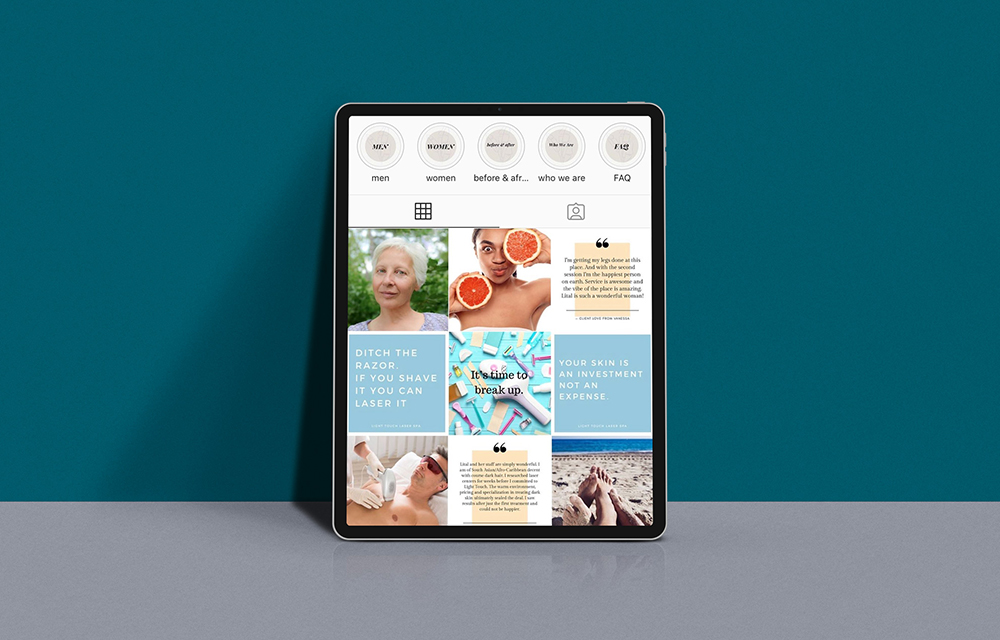Remember Kim Kardashian’s famous “Vampire Facial” Instagram post? You probably do. Posted in March of 2013, it amassed 150,000 likes and 10,000 comments and was shared countless times across the internet in the form of other social posts and commentary on beauty sites.
Besides demonstrating the power of the celeb influencer, this viral post may have also played an early role in paving the way for social media to become the ripe marketing space it is today for medical aesthetic companies. That’s because as celebs and beauty influencers – everyone from Kim K and Chrissy Teigen to Cindy Crawford and Gwyneth Paltrow – become more open about their aesthetic treatments on social media, this kind of content becomes very normal, accepted, and even valued as a resource by consumers. So it would be a major misstep for practitioners not to meet potential patients in their preferred arena. Not to mention, this organic way of marketing is totally free (that is, unless you get into paid campaigns, which are also a good idea, but not something we’re going to tackle in this post).
Eager to get started? Hold your horses. It’s not as simple as posting a picture. Leveraging social media to your benefit requires a time commitment and a good strategy to reach your target audience. Here are 10 ways to tap into this marketing tool – and do it right.
1. Commit to Only 1 or 2 Platforms to Start
As a practitioner, your time is your most valuable resource, so don’t try to start on all platforms at once. If you do, chances are you’ll start out strong but then struggle to maintain momentum across all. Pick no more than three platforms to commit to and master them before adding in more. And because demographics vary by social media platform, be sure to pick platforms that closely align with your target audience. You can learn more about all platform demographics here, as reported in a 2019 study done by the Pew Research Center. Since Facebook and Instagram are likely the main platforms your clients are using, that’s what we’re going to focus mostly on in this post.
Secondly, utilize scheduling tools to save time. Hootsuite, AgoraPulse, and Loomly and are all examples of scheduling software that allow you to collaborate, publish, and measure all your online platforms in one place.
FREE E-BOOK
5 Ways to Boost Social Media ROI for Medical Aesthetic Practices
This free e-book will help supercharge your social media ROI
2. Evaluate the Best Content for Each Platform
According to a 2017 “Cosmetic Surgery on Social Media” survey conducted by the American Society of Plastic Surgeons (ASPS), users want to see before-and-after photos, information on procedures, as well as videos of procedures being performed (yes, really!). So how do you give them what they want using Facebook and Instagram?
Use this platform for shorter content and pictures – ideally for quick posts, sale announcements, and before-and-after shots. Since before-and-after shots can be somewhat sterile-looking and not always pleasing to the eye, make sure they don’t overrun your feed. Rather, consider saving them to a special “Before & After” album on your page for people to click into if they want to see more.
Since Instagram is a highly visual platform, reserve your feed for inspirational visuals that convey natural, healthy, and effortless-looking beauty and well-being (more on this in #4), but with brief captions that reference the treatments that lead to these kinds of looks. Use the Highlights feature (more on this #8) to share before and after images rather than your permanent feed. Lastly, user-generated content (UGC) is also great to share in your Stories, as well as the Highlights section, but stick to posting UGC images that are high quality and in line with your brand vibe.
Videos
While informative, videos of procedures being performed are admittedly not always aesthetically pleasing, so the best home for them is in your IGTV channel (which you manage via a standalone app) or your Facebook Videos section – all it requires is a smartphone camera, a few apps, and some creative ideas. In fact, Facebook provides some video ideas, tips, apps, and tutorials for both its platform and Instagram here.
Another option is to share them on your website or separate YouTube channel, where you can link to this content from your other social platforms. Just be careful not to tease the post with an off-putting procedural image and warn viewers if it is somewhat graphic.
Lastly, experiment with various formats and content. Over time, you’ll learn what generates the best level of engagement from your ideal audience while being practical for your clinic.
3. Be Honest & Authentic in Your Posts
On one hand, social media has become a wonderful platform for beauty campaigns that promote inclusivity for all genders, races, ethnicities, and body types. On the other hand, it can also minimize risks associated with procedures, promote unrealistic expectations, and increase psychological pressure to achieve perfection. Whatever you post, be honest in setting expectations regarding downtime after procedures or the number of sessions required to achieve desired results. You don’t want to be posting something you can’t promise as it can affect your practice’s trustworthiness.
4. Maximize Visual Content – The Right Kind of Visual Content
The bulk of your images should convey natural, healthy, and effortless-looking beauty and well-being – what your clients’ beauty aesthetics aspire to be. The reasoning? Visual content is what attracts users and makes them want to follow you. Instagram and Pinterest are the most visual social media platforms, but even Facebook posts are proven to perform better when accompanied by photos. There’s a lot of competition on social media and having high-quality images is considered a must if you want to grow your engagement.
So where do you get those visuals? If you don’t have an arsenal of professional photography at your disposal, look to stock sites, like Shutterstock, which requires a paid subscription, or Unsplash, offering less variety but for free. The beauty of beauty images is that they’re plentiful, so finding the type of photos that fit your brand’s vibe shouldn’t be difficult.
5. Remember to Weave in Value-Driven Content
Again, people use social media as a resource to evaluate procedures and treatments. And as an expert in the medical aesthetics field, you’re just the right person to give them that information. In addition to regular posts that promote your newest services, products, or other, be sure to include links to longer-form content where they can learn more. Ideally, that longer-form content lives on your own blog to chauffeur users to your website (check out our post Content & Email Strategy for Med Spas: Part 1 to dive into the recipe for a solid content strategy). Facebook, in particular, is a great place to push that content out. Instagram is too; however, the links aren’t clickable in the caption format, so either provide a shortened link or, better yet, share the link in your bio and reference it in the caption.
6. Establish a Consistent Posting Cadence as Well as Style
Your messaging tone, colors, and imagery should be consistent across all platforms you are using, as it will help users know what to expect when following you, and cultivates your specific brand imaging.
As for posting frequency, each social media platform has a different ideal posting frequency. The sweet spot for posting on Facebook is a few times a week, Instagram is daily, Twitter is a few times a day, and LinkedIn is once a week. But remember, this is a rough estimate based on industry research and advice. The best thing you can do is keep track of how many posts you’re sharing per day in a spreadsheet, take a look at your analytics after a few weeks, and use the data to determine whether you need to beef up or scale back your frequency.
SOLUTIONS
Set Yourself Apart From the Competition
Activate our cost-effective, turnkey medical aesthetic marketing solutions
7. Be Active & Engage Often
Your practice needs to feel approachable and trustworthy – that’s why it’s important to interact with your users. Check direct messages often and reply always; in posts, reply or simply like comments from those who respond. Creating that connection will, at once, win over prospective clients and beat out all idle competition.
Additionally, don’t shy away from responding to bad reviews or critical comments. Be courteous and professional in any response and ask what you could have done differently. You may turn unhappy clients around, and, even if you don’t, your other clients will see that you care.
8. Use App Features to Your Advantage
On Instagram, the Stories and Highlights features have transformed how users engage. For example, you can use Stories to point to new blog posts on your website or solicit questions about procedures or treatments that users might have that you can then answer in other permanent posts. The Highlights section is also a great way to take users inside your practice through imagery, catalog before-and-after photos, or UGC (user-generated content), and share favorite products or brief looks into certain procedures in action.
Similarly, for longer-form video content, Instagram and Facebook’s live-streaming video feature is a good way to demo products or have aestheticians speak to or demystify certain technologies.
9. Leverage Testimonials or UGC (User-Generated Content)
Now more than ever, peer-to-peer endorsements hugely impact consumer buying decisions, and happy clients can be your best ambassadors. Recruit patients to write reviews on Facebook (maybe throw in an incentive, like a free product or a discount on their next treatment) or encourage them to use the “Check-In” feature when they arrive for their appointment, prompting friends to click on your page for more information.
Also, if a user tags your practice in a personal post about feeling or looking great thanks to a particular procedure, treatment, or product on Instagram, use it (just be sure to attribute to them)! If their image isn’t great quality or quite on-brand, you can still share it in your Stories or add it to a Highlights reel titled something clever like “Our Glowing Clients.”
10. Make Contacting You & Finding Your Website Easy
It’s important to not lose sight of why you’re working so hard on developing and maintaining your social media: to, eventually, convert clients (read: funnel those followers to your website, where they can access key information regarding your services or book a consultation). On Instagram, that means linking your website and address (or greater area you serve) in your bio, as well as including a “Contact” button for phone number and email. On Facebook, when first setting up your business page, you’ll be prompted to enter your clinic’s address, contact information, and hours. There’s also an “About” section and “Contact Me” call-to-action button that you can include.
While contact info seems like an obvious thing to include, it can get overlooked as practices try to make sure they’re following all of the above steps. And it’s arguably the most important, as it renders all other strategies useless if you’re lacking the means to assist prospects in conversion.
Does all this sound great, but you’re not sure how to put it into action?
Our team of designers, writers, and strategists are at your digital disposal. Just drop us a line any time.



